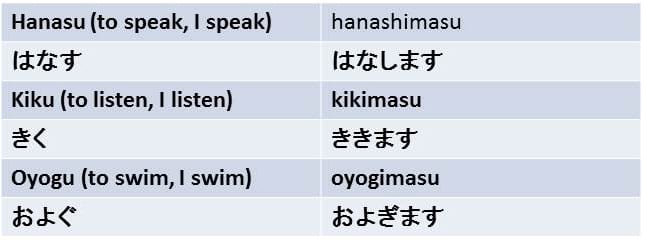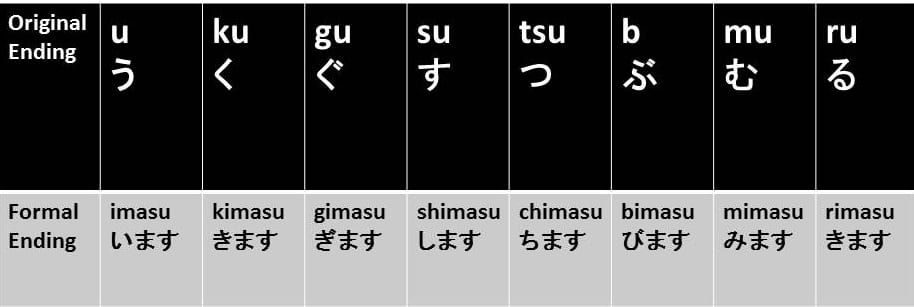When you’re learning Japanese, it’s important to understand how to conjugate verbs in Japanese. Here are some great tips from Ann Arbor, MI teacher Elaina R. to help you understand Japanese verb conjugation….
Now that you’re familiar with Japanese kana (if you’re not, check out this article) and a few essential phrases, you’re ready to learn about Japanese verb conjugation. In this article we will cover the basics—just the infinitive and present (formal and informal) forms. These concepts may seem confusing at first, but with consistent practice and a little help from a Japanese tutor, you can learn how to conjugate Japanese verbs.
Japanese Subjects
Here’s a quick grammar review: the subject of the sentence completes the action of the sentence.
- I run
- She eats
In most languages, we conjugate the verb according to the subject.
- I run
- you run
- he/she runs
In Japanese, the verb doesn’t change according to the subject. If the subject isn’t identified, we infer that the speaker is referring to herself or himself. This means you only need one word to form a sentence, which is kind of nice.
aruku (あるく): to walk, I walk
Infinitive/Present Informal Verb Forms
If you’ve ever taken Spanish classes, you know that infinitive verbs translate to “to+verb” in English. For example, hablar means to speak.
In Japanese, infinitive verb forms are also used as informal present tense. They always end with the vowel “u”.
- hanasu (to speak, I speak): はなす – hanashimasu: はなします
- kiku (to listen, I listen): きく – kikimasu: ききます
- oyogu (to swim, I swim): およぐ – oyogimasu およぎます
In the Japanese alphabet, there are nine letters that end with u, but not all of these are used as verb endings. On the other hand, some are used as verb endings with dakuten. Dakuten are kana with a quotation mark or circle next to the character. The added dakuten changes the sound and pronunciation.
Here are the letters that can end a Japanese infinitive verb:
Present Formal Verb Forms
Here’s where we start conjugating. Again, if you took Spanish at some point, you might remember that there are formal and informal verb endings.
- tu hablas – you speak (informal)
To make Japanese verbs formal, we add –masu to the end of the verb. The original “u” ending changes into an “i,” and the consonant before the original ending changes to accommodate the new ending.
Here are the formal Japanese conjugation for each verb ending:
Exceptions and Irregular Verbs
Of course, every language has pesky irregular verbs that don’t follow the rules. Some infinitive verb endings have different conjugations in Japanese.
Some verbs end with –iru or –eru
- taberu – to eat, I eat (たべる)
- miru – to see, I see (みる)
Here are the formal conjugations of these verbs:
- tabemasu – to eat, I eat (たべます)
- mimasu – to see, I see (みます)
Notice that the -ru is simply cut from the original verb and replaced with –masu.
The verbs “to do” and “to come” are also irregular.
- suru: (to eat, I eat) する – shimasu: します
- kuru: (to come, I come) くる – kimasu: きます
Instead of losing the last letter, these words transform entirely in the formal form.
Verb It Up
This may seem like a lot to remember, but with these study tips, diligence, and help from a good Japanese tutor, you can learn Japanese verb conjugations. 頑張って(you can do it!)
 Elaina R. teaches singing in Ann Arbor, MI. She is acquainted with many languages and speaks English, Japanese, Italian, and German. As a singer, she pays particular attention to pronunciation. She earned a Bachelor of Music from the University of Southern California, and she is currently working on her Master of Music from the University of Michigan. Learn more about Elaina here!
Elaina R. teaches singing in Ann Arbor, MI. She is acquainted with many languages and speaks English, Japanese, Italian, and German. As a singer, she pays particular attention to pronunciation. She earned a Bachelor of Music from the University of Southern California, and she is currently working on her Master of Music from the University of Michigan. Learn more about Elaina here!
Maile Proctor





